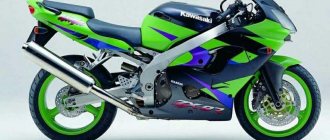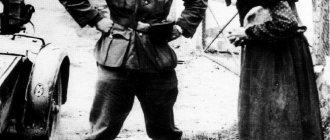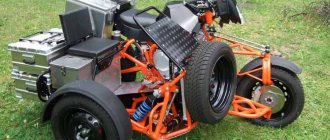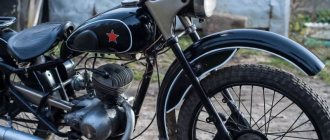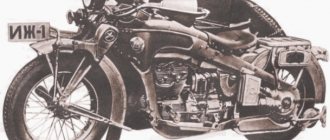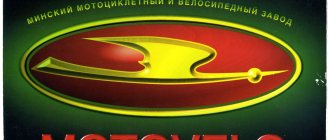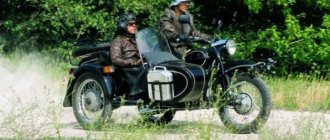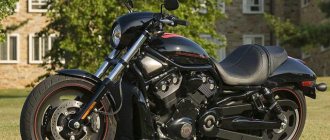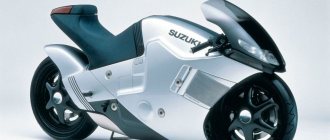A copy based on the MT-9 motorcycle that has survived to this day.
0
See all photos in the gallery
In the Soviet Union, they also tried to keep up with the technical fashion of the time, so domestic design bureaus and research institutes were actively involved in the topic of RPD, and VAZ even launched small-scale production of models with this advanced power plant. Back in the early 60s, TsKEB (Central Design and Experimental Bureau of Motorcycle Manufacturing in Serpukhov) began designing a rotary piston engine. The first working prototype of the engine, the RD-250, was created in 1961. It had a cast iron body and air cooling. It was possible to achieve stable operation of the RPD at frequencies up to 6000 rpm (at the same time, the engine developed a power of 8.5 hp). However, with further boost of the engine to 17 hp. at 9000 rpm, problems appeared associated with low efficiency of seals and large mechanical losses. They were resolved by using more efficient seals, changing the shape of the windows and combustion chamber, and switching to rolling bearings. The accumulated experience made it possible in 1964 to begin developing a RPD designed directly for installation on a motorcycle. The technical specifications provided for the creation of a motor with a power of 30-35 hp. for Kyiv and Irbit heavy motorcycles with sidecars. In 1970, a 1-section rotary piston engine RD-350V with a power of 30.5 hp was built. For road testing, it was installed in the chassis of a standard Dnepr K-650 motorcycle. Such a device demonstrated satisfactory dynamic performance, but had a very low resource - only 100 hours of operation.
0
×
0
After 2 years, engineers created a modernized RD-500V installation with an aluminum alloy body and a chrome-plated working surface. Such a 500 cc engine already developed 40 hp. at 6000 rpm. There were also attempts to equip the unit with a fuel injection system, but this idea was quickly abandoned due to problems with starting a cold engine. This RPD was used to equip the more modern Dnepr MT-9 motorcycle: in 1974, a pilot batch of 10 vehicles was produced.
0
A further development of the RD-500V was the RD-501 motor (1973), in which a wear-resistant nickasil coating of the aluminum body was used. The engine rotor was made of sintered aluminum alloy, and ignition of the fuel-air mixture was provided by an electronic contactless ignition system. 30 of these motorcycles were produced.
0
Tests showed that air cooling was not suitable for a rotary engine, so in 1976 they developed a more advanced design - the RD-510. This rotary piston engine already produced 48 hp. and featured a liquid cooling system. In 1979, a batch of 30 cars with a modified chassis from the Dnepr motorcycle was produced. They were distributed to the chairmen of the surrounding collective farms - the most severe conditions of real exploitation. Further work was aimed at improving engine reliability, reducing fuel consumption and exhaust toxicity.
2: Norton F1.
Considering Norton's successful racing performances with Wankel engines, the decision to install such an engine on the Commander, which was a tourer, seems strange. But this oddity was eliminated in the 1990s with the release of the Norton F1, an almost full-fledged sportsbike, similar in design to the first generations of the CBR600, CBR1000 and Ducati Paso. About 130 motorcycles were produced.
Motorcycles with RPD - domestic developments from VNIImotoprom
Interestingly, there were developments in the field of RPD in the Soviet Union. And if many people know about the VAZ rotary car, then the existence in the past of domestic motorcycles with engines built according to the Wankel scheme still remains a secret for many.
Back in 1970, road tests of the RD-350V engine, installed in a chassis from the Dnepr K-650, began. The dynamics of the car turned out to be satisfactory, the engine power was increased to 30.5 hp, but the very short life of the engine (only 100 hours) did not allow the development to see a bright future.
In 1972, a new version of the RPD was created - RD-500V. Its body is made of aluminum alloy, with a chrome-plated working surface. The engine developed a power of 40 hp. at 6000 rpm. Road tests of the engine were carried out in the chassis of the Dnepr MT-9 motorcycle. They first tested a fuel injection system on it, but later abandoned it due to difficulty starting a cold engine (fuel injection systems of those times were far from perfect). The development of the RD-500V was the RD-501, created in 1973, in which a wear-resistant nickel-silver coating of the aluminum body was used, the engine rotor was made of sintered aluminum alloy, and the ignition of the fuel-air mixture was ensured by an electronic contactless ignition system.
A decisive step was the transition to a liquid cooling system in 1976. This engine, designated RD-510, already developed 48 hp. at 6000 rpm. Further work was aimed at increasing the “survivability” of the engine, reducing fuel consumption and exhaust gas toxicity.
The single-section RD-515 was supposed to be installed on heavy motorcycles in the mid-70s. With a weight of 38 kg and a volume of 491 cm3. it produced 38 hp. (6000 rpm) and 51 Nm (3500 rpm). The end seals were made of steel or cast iron. Especially for this motor, they developed a technology for applying a wear-resistant, heat-resistant nickel-silicon coating “Nikosil” to an aluminum base. The unit was nursed for 50 thousand km before major repairs.
The latest projects known to us in the field of domestic motorcycles with RPD are the RD-660 devices developed in the mid-80s and the RD-601 escort motorcycle (613 cc, power 52 hp at 6000 rpm)
It becomes clear that by the beginning of “perestroika” in the 90s, the institute had several proven RPD designs. But the further turn of events in our country killed all hopes for any successful continuation of development. Today, Soviet-era developments in the field of rotary piston engines can be observed in this state:
Found on the Internet.
6: Norton Classic.
The result of endless design research was the production of the Norton Classic rotary motorcycle. Using the same twin-rotor 588 cc air-cooled engine as the Interpol II, the bike was limited to 100 units. This was the first attempt to produce a production rotary motorcycle in 11 years, since 1987, when motorcycle enthusiasts were able to see the Suzuki RE5.
10: Hercules/DKW W-2000.
First on our list will be the oldest motorcycle with a Wankel engine. This is a Hercules, designated in the UK as the DKW W-2000. The sales record holder among motorcycles with a rotary engine, producing 30 horsepower with an engine capacity of 294 cubic centimeters (although the volume of rotary engines cannot be compared with the volume of piston engines).
This motorcycle was produced in Germany from 1974 to 1977. 1800 copies were produced. As a drive to the wheel there is a universal joint, powered by a Bing carburetor.
9: Yamaha RZ201.
Don't worry, this is not a gap in your knowledge of motorcycle history. Yamaha never really mass-produced rotary-engined motorcycles, but it was already on the verge of doing so. In 1972, at the Tokio Motor Show, a Yamaha RZ201 motorcycle with a 660 cc Wankel engine producing 66 horses was shown. Unfortunately, only a few prototypes were built, but if you really like this bike, you can turn your attention to the Yamaha TX750, with a traditional engine, but on the same frame and similar design.
1: Norton F1 Sport.
Finally a true sportsbike was released, earning itself a decent racing reputation at races such as the BSB and TT. Compared to the previous version, the side plastic was changed, now giving aesthetes a view of the elegant frame, and the shape of the saddle was changed. Unfortunately, at that time the Norton company was already in a state of agony, so it assembled the F1 Sport more for the sake of selling the remaining spare parts than for the sake of attracting consumers. In any case, the next rotary F2, although shown to the public in 1992, never entered the production line.
All.
Share “TOP 10 motorcycles with rotary engines.”
Disadvantages of the Soviet superbike IZH Moto
Soviet motorcycles were not the most remarkable in their segment. However, they still managed to gain popularity in different countries. This can be explained by the fact that engineers have always thought through the technical component of these vehicles. The main advantage was the use of rotary piston engines, which were small in size and significantly improved the technical part of the motorcycle.
We decided to use the RD-601 two-section rotary piston engine as the power unit.
The most popular brand under which Soviet motorcycles entered the market is Izh. The engineers of this plant at one time developed an export modification with rotary piston engines. At the end of the 1980s, an experimental model of an export motorcycle was developed and equipped with one. Specialists from the Izhevsk Motor Plant were assigned to work on this project. Interestingly, this was a full-fledged government order, within which it was necessary to put the model into small-scale production.
They decided to use a two-section rotary piston engine RD-601 as the power unit. Its working volume is 613 cubic meters and its power is 52 hp. The revolutions per minute reached 6000, and the torque reached 51 Nm. Such an installation was created in Togliatti and unified with VAZ rotary engines. Note that the latter already at that time began to be actively used in cars for special services.
Its main drawback was that it appeared at the wrong time
Design searches led to the birth of several running prototypes of the Soviet superbike. In their appearance, they resembled the best examples of Japanese and German models.
The question of whether these motorcycles had any shortcomings cannot be answered so unequivocally. We can only say that this was the best version of all the models assembled on the territory of the Soviet Union. Its main drawback was that it appeared at the wrong time.
IZH Vega
The first prototype is IZH Leader. This motorcycle had a well-developed hood and massive fairings. The latter provide good protection for the driver from wind and precipitation. If you pay attention to the contours, they are somewhat reminiscent of the legendary BMW K1 sports motorcycle, which appeared around this time. The engine thrust in this motorcycle was transmitted to the rear wheel using a cardan. A total of two prototypes of the Leader were built. The first was equipped with a rotary piston engine, and the design of the second offered a two-cylinder boxer engine from the Ural production model.
IZH Vega
Another export option is Vega. It featured a more rapid and sleek design. His appearance did not evoke associations with medieval knights. The appearance was almost equal to the best Western motorcycles. However, some elements in the design looked alien. This may include brake mechanisms or spoked wheels. There was also a more down-to-earth version of this export motorcycle. A 650cc boxer engine from a Dnepr motorcycle was installed here.
Perestroika and all the problems in the USSR economy, which subsequently led to the collapse of the country, put an end to such promising developments
The developers' plans were quite ambitious even then. They wanted to establish serial production of such motorcycles and organize large deliveries abroad. Such transport could be useful in police service in different countries. Unfortunately, the export version never made it onto the production line. Perestroika and all the problems in the USSR economy, which subsequently led to the collapse of the country, put an end to such promising developments. It is worth paying tribute to the appearance of these projects. They were not inferior even to foreign sports motorcycles of that period. However, the design still had elements that looked outdated - drum brakes and spoked wheels.
It was possible to develop the project within the country, but financial and political reasons prevented this
If we consider the real reasons for the failure of this project, we can highlight not only the political aspect. Perestroika and the subsequent collapse was not the main reason. The fact is that the bike, although it was close, was still inferior to its foreign counterparts. Therefore, there was no point in sending it for export even at a lower cost.
Of course, it was possible to develop the project within the country, but financial and political reasons prevented this. Note that production of such products has not yet been established in Russia. Some explain this by low demand, but it may also be due to production skills.
Bottom line . In the 1980s, the USSR was developing export motorcycles IZH. In total, several versions were developed, but none of them made it into series. The main disadvantage was that they appeared and were developed at the wrong time.
3: Suzuki RE5.
In fact, if you want a rotary motorcycle experience, you'll almost certainly come to the Suzuki RE5. While competitors were limited to producing small batches, Suzuki was able to establish truly mass production of rotary motorcycles. You can still find a couple on ebay and buy them. The engine is single-rotor (less likely to cause any problems), 65 horsepower, which could not boast of power even in 1975, but the motorcycle has a neat design and a distinctive style of the tail light and dashboard.
8: Norton Interpol II
Norton worked on a prototype rotary motorcycle during the 70s of the last century, but such motorcycles did not go into production until 1984. However, the production was small-scale, it was something between a prototype and a production model, so if the plastic seemed familiar to you, you were not mistaken - the entire body kit was taken from a BMW R100RT motorcycle, the favorite motorcycle of the police in those years.

